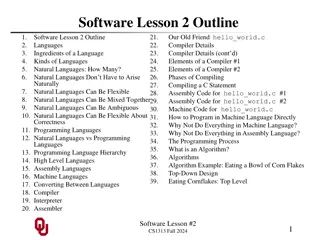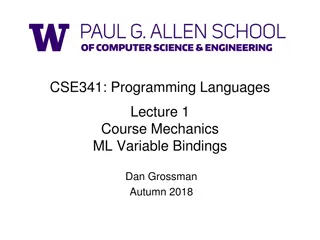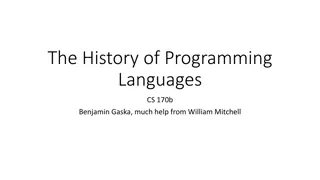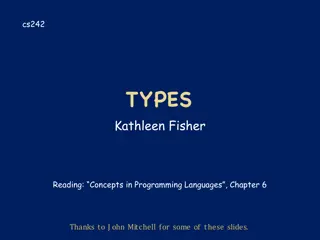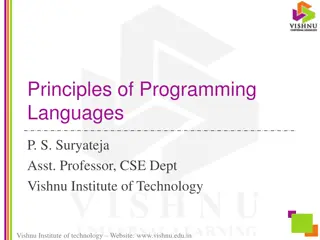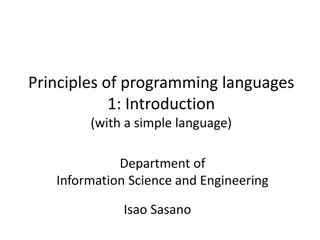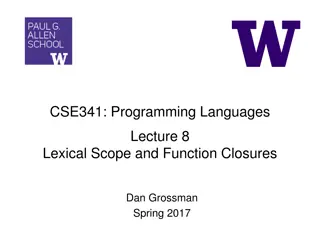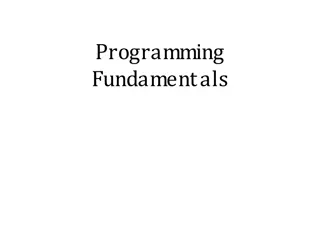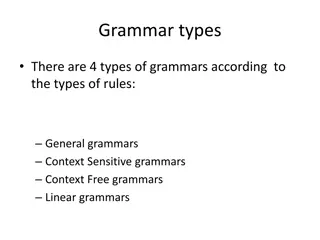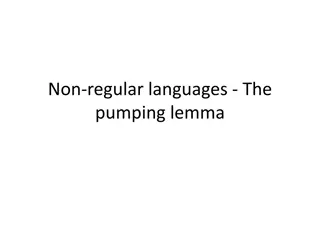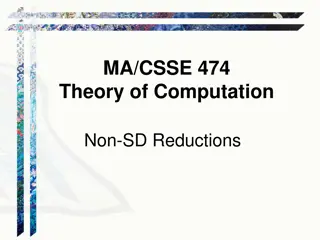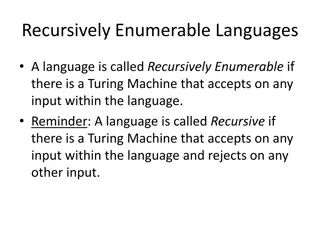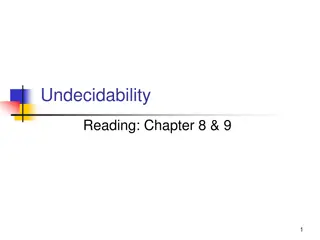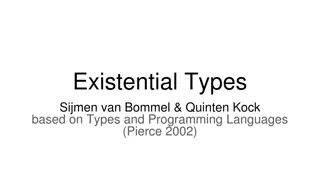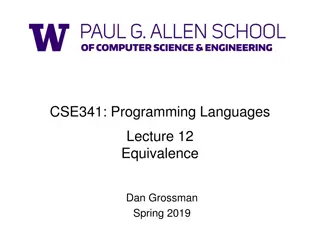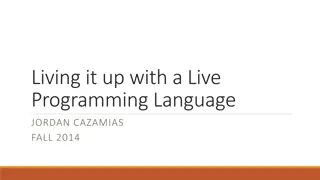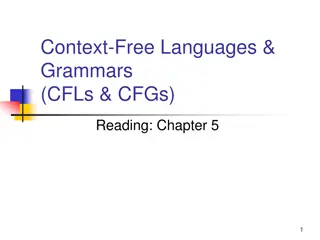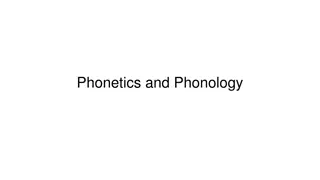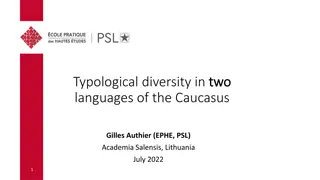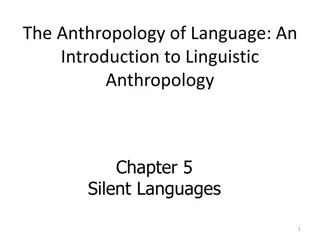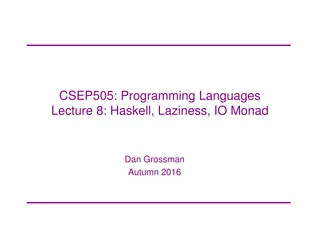Understanding Types in Programming Languages: Lecture Insights
The lecture delves into the intricacies of types in programming languages, focusing on simply-typed Lambda-Calculus, safety, preservation, progress, and extensions like pairs, datatypes, and recursion. It discusses static vs. dynamic typing, Curry-Howard Isomorphism, subtyping, type variables, generics, abstract types, recursive types, and type inference. The content emphasizes the importance of defining sound and complete type systems through examples and rules.
Download Presentation

Please find below an Image/Link to download the presentation.
The content on the website is provided AS IS for your information and personal use only. It may not be sold, licensed, or shared on other websites without obtaining consent from the author. Download presentation by click this link. If you encounter any issues during the download, it is possible that the publisher has removed the file from their server.
E N D
Presentation Transcript
CSEP505: Programming Languages Lecture 6: Types, Types, Types Dan Grossman Autumn 2016
Our plan Simply-typed Lambda-Calculus Safety = (preservation + progress) Extensions (pairs, datatypes, recursion, etc.) Digression: static vs. dynamic typing Digression: Curry-Howard Isomorphism Subtyping Type Variables: Generics ( ), Abstract types ( ) Type inference Lecture 6 CSE P505 August 2016 Dan Grossman 2
STLC in one slide Expressions: e ::= x | x. e | e e | c Values: v ::= x. e | c Types: ::= int | Contexts: ::= . | , x : e1 e1 e2 e2 e1e2 e1 e2 ve2 ve2 ( x.e)v e{v/x} e e c : int x : (x) e: ,x: 1 e: 2 e1: 1 2 e2: 1 ( x.e): 1 2 e1 e2: 2 Lecture 6 CSE P505 August 2016 Dan Grossman 3
Rule-by-rule c : int x : (x) ,x: 1 e: 2 e1: 1 2 e2: 1 ( x.e): 1 2 e1 e2: 2 Constant rule: context irrelevant Variable rule: lookup (no instantiation if x not in ) Application rule: yeah, that makes sense Function rule the interesting one Lecture 5 CSE P505 Autumn 2016 Dan Grossman 4
The function rule ,x: 1 e: 2 ( x.e): 1 2 Where did 1 come from? Our rule inferred or guessed it To be syntax-directed, change x.eto x: .eand use that If we think of as a partial function, we need x not already in it (implicit systematic renaming [alpha-conversion] allows) Or can think of it as shadowing Lecture 5 CSE P505 Autumn 2016 Dan Grossman 5
Our plan Simply-typed Lambda-Calculus Safety = (preservation + progress) Extensions (pairs, datatypes, recursion, etc.) Digression: static vs. dynamic typing Digression: Curry-Howard Isomorphism Subtyping Type Variables: Generics ( ), Abstract types ( ), Recursive types Type inference Lecture 5 CSE P505 Autumn 2016 Dan Grossman 6
Is it right? Can define any type system we want What we defined is sound and incomplete Can prove incomplete with one example Every variable has exactly one simple type Example (doesn t get stuck, doesn t typecheck) ( x. (x ( y.y)) (x 3)) ( z.z) Lecture 5 CSE P505 Autumn 2016 Dan Grossman 7
Sound Statement of soundness theorem: If . e: and e *e2, then e2 is a value or there exists an e3 such that e2 e3 Proof is non-trivial Must hold for all e and any number of steps But easy given two helper theorems 1. Progress: If . e: ,then e is a value or there exists an e2 such that e e2 2. Preservation: If . e: and e e2, then . e2: Lecture 5 CSE P505 Autumn 2016 Dan Grossman 8
Lets prove it Prove: If . e: and e *e2, then e2 is a value or e3 such that e2 e3, assuming: 1. If . e: then e is a value or e2 such that e e2 2. If . e: and e e2 then . e2: Prove something stronger: Also show . e2: Proof: By induction on n where e *e2 in n steps Case n=0: immediate from progress (e=e2) Case n>0: then e3such that Lecture 5 CSE P505 Autumn 2016 Dan Grossman 9
Whats the point Progress is what we care about But Preservation is the invariant that holds no matter how long we have been running (Progress and Preservation) implies Soundness This is a very general/powerful recipe for showing you don t get to a bad place If invariant holds, then (a) you re in a good place (progress) and (b) anywhere you go is a good place (preservation) Details on next two slides less important Lecture 5 CSE P505 Autumn 2016 Dan Grossman 10
Forget a couple things? Progress: If . e: then e is a value or there exists an e2 such that e e2 Proof: Induction on height of derivation tree for . e: Rough idea: Trivial unless e is an application For e = e1 e2, If left or right not a value, induction If both values, e1 must be a lambda Lecture 5 CSE P505 Autumn 2016 Dan Grossman 11
Forget a couple things? Preservation: If . e: and e e2 then . e2: Also by induction on assumed typing derivation. The trouble is when e e involves substitution Requires another theorem Substitution: If ,x: 1 e: and e1: 1, then e{e1/x}: Lecture 5 CSE P505 Autumn 2016 Dan Grossman 12
Our plan Simply-typed Lambda-Calculus Safety = (preservation + progress) Extensions (pairs, datatypes, recursion, etc.) Digression: static vs. dynamic typing Digression: Curry-Howard Isomorphism Subtyping Type Variables: Generics ( ), Abstract types ( ), Recursive types Type inference Lecture 5 CSE P505 Autumn 2016 Dan Grossman 13
Having laid the groundwork So far: Our language (STLC) is tiny We used heavy-duty tools to define it Now: Add lots of things quickly Because our tools are all we need And each addition will have the same form Lecture 6 CSE P505 August 2016 Dan Grossman 14
A method to our madness The plan Add syntax Add new semantic rules Add new typing rules Such that we remain safe If our addition extends the syntax of types, then New values (of that type) Ways to make the new values called introduction forms Ways to use the new values called elimination forms Lecture 6 CSE P505 August 2016 Dan Grossman 15
Let bindings (CBV) e ::= | let x = e1 in e2 (no new values or types) e1 e1 let x = e1 in e2 let x = e1 in e2 let x = v in e2 e2{v/x} ,x: 1 e2: 2 e1: 1 let x = e1 in e2 : 2 Lecture 6 CSE P505 August 2016 Dan Grossman 16
Let as sugar? let is actually so much like lambda, we could use 2 other different but equivalent semantics 2. let x = e1 in e2 is sugar (a different concrete way to write the same abstract syntax) for ( x.e2) e1 3. let x = e1 in e2 ( x.e2) e1 Instead of rules on last slide, just use Note: In OCaml, let is not sugar for application because let is type- checked differently (type variables) Lecture 6 CSE P505 August 2016 Dan Grossman 17
Booleans e ::= | tru | fls | e ? e : e v ::= | tru | fls ::= | bool e1 e1 e1 ? e2 : e3 e1 ? e2 : e3 tru ? e2 : e3 e2 fls ? e2 : e3 e3 tru:bool fls:bool e1:bool e2: e3: e1 ? e2 : e3 : Lecture 6 CSE P505 August 2016 Dan Grossman 18
OCaml? Large-step? In Homework 3, you add conditionals, pairs, etc. to our environment-based large-step interpreter Compared to last slide Different meta-language (cases rearranged) Large-step instead of small Large-step booleans with inference rules: tru tru fls fls e1 ? e2 : e3 v e1 ? e2 : e3 v e1 tru e2 v e1 fls e3 v Lecture 6 CSE P505 August 2016 Dan Grossman 19
Pairs (CBV, left-to-right) e ::= | (e,e) | e.1 | e.2 v ::= | (v,v) ::= | * e1 e1 (e1,e2) (e1 ,e2) (v,e2) (v,e2 ) e.1 e .1 e2 e2 e e e e e.2 e .2 (v1,v2).1 v1 (v1,v2).2 v2 e1: 1 e2: 2 (e1,e2): 1* 2 e.1: 1 e: 1* 2 e: 1* 2 e.2: 2 Lecture 6 CSE P505 August 2016 Dan Grossman 20
Toward Sums Next addition: sums (much like ML datatypes) Informal review of ML datatype basics type t = A of t1 | B of t2 | C of t3 Introduction forms: constructor applied to expression Elimination forms: match e1 with pat -> exp Typing: If e has type t1, then A e has type t Lecture 6 CSE P505 August 2016 Dan Grossman 21
Unlike ML, part 1 ML datatypes do a lot at once Allow recursive types Introduce a new name for a type Allow type parameters Allow fancy pattern matching What we do will be simpler Skip recursive types [an orthogonal addition] Avoid names (a bit simpler in theory) Skip type parameters Only patterns of form A x and B x (rest is sugar) Lecture 6 CSE P505 August 2016 Dan Grossman 22
Unlike ML, part 2 What we add will also be different Only two constructors A and B All sum types use these constructors So A e can have any sum type allowed by e s type No need to declare sum types in advance Like functions, will guess types in our rules This still helps explain what datatypes are After formalism, compare to C unions and OOP Lecture 6 CSE P505 August 2016 Dan Grossman 23
The math (with type rules to come) e ::= | A e | B e | match e with A x ->e | B x -> e v ::= | A v | B v ::= | + e e e e A e A e B e B e match e1 with A x->e2 |B y -> e3 match e1 with A x->e2 |B y -> e3 e1 e1 match A v with A x->e2 | B y -> e3 e2{v/x} match B v with A x->e2 | B y -> e3 e3{v/y} Lecture 6 CSE P505 August 2016 Dan Grossman 24
Low-level view You can think of datatype values as pairs First component: A or B (or 0 or 1 if you prefer) Second component: the data e2 or e3 of match evaluated with the data in place of the variable This is all like OCaml as in Lecture 1 Example values of type int + (int -> int): x. [( y ,6)] x+y 0 17 1 Lecture 6 CSE P505 August 2016 Dan Grossman 25
Typing rules Key idea for datatype expression: other can be anything Key idea for matches: branches need same type Just like conditionals e: 1 A e : 1+ 2 B e : 1+ 2 e: 2 e1 : 1+ 2 ,x: 1 e2 : ,y: 2 e3 : match e1 with A x->e2 | B y ->e3 : Lecture 6 CSE P505 August 2016 Dan Grossman 26
Compare to pairs, part 1 pairs and sums is a big idea Languages should have both (in some form) Somehow pairs come across as simpler, but they re really dual (see Curry-Howard soon) Introduction forms: pairs: need both , sums: need one e1: 1 e2: 2 (e1,e2) : 1* 2 A e : 1+ 2 B e : 1+ 2 e: 1 e: 2 Lecture 6 CSE P505 August 2016 Dan Grossman 27
Compare to pairs, part 2 Elimination forms pairs: get either , sums: be prepared for either e: 1* 2 e: 1* 2 e.1: 1 e.2: 2 e1 : 1+ 2 ,x: 1 e2 : ,y: 2 e3 : match e1 with A x->e2 | B y->e3 : Lecture 6 CSE P505 August 2016 Dan Grossman 28
Living with just pairs If stubborn you can cram sums into pairs (don t!) Round-peg, square-hole Less efficient (dummy values) More error-prone (may use dummy values) Example: int + (int -> int) becomes int * (int * (int -> int)) x. x. 0 17 [ ] x. y. x+y 1 0 [( y ,6] Lecture 6 CSE P505 August 2016 Dan Grossman 29
Sums in other guises type t = A of t1 | B of t2 | C of t3 match e with A x -> Meets C: struct t { enum {A, B, C} tag; union {t1 a; t2 b; t3 c;} data; }; switch(e->tag){ case A: t1 x=e->data.a; No static checking that tag is obeyed As fat as the fattest variant (avoidable with casts) Mutation costs us again! Some modern progress in Rust, Swift, ? Lecture 6 CSE P505 August 2016 Dan Grossman 30
Sums in other guises type t = A of t1 | B of t2 | C of t3 match e with A x -> Meets Java [C# similar]: abstract class t {abstract Object m();} class A extends t { t1 x; Object m(){ }} class B extends t { t2 x; Object m(){ }} class C extends t { t3 x; Object m(){ }} e.m() A new method for each match expression Supports orthogonal forms of extensibility New constructors vs. new operations over the dataype! Lecture 6 CSE P505 August 2016 Dan Grossman 31
Where are we Have added let, bools, pairs, sums Could have added many other things Amazing fact: Even with everything we have added so far, every program terminates! i.e., if . e: then there exists a value v such that e * v Corollary: Our encoding of recursion won t type-check To regain Turing-completeness, need explicit support for recursion Lecture 6 CSE P505 August 2016 Dan Grossman 32
Recursion Could add fix e , but most people find letrec f x . e more intuitive e ::= | letrec f x . e v ::= | letrec f x . e (no new types) Substitute argument like lambda & whole function for f (letrec f x . e) v (e{v/x}){(letrec f x . e) / f} , f: 1 2, x: 1 e: 2 letrec f x . e : 1 2 Lecture 6 CSE P505 August 2016 Dan Grossman 33
Our plan Simply-typed Lambda-Calculus Safety = (preservation + progress) Extensions (pairs, datatypes, recursion, etc.) Digression: static vs. dynamic typing Digression: Curry-Howard Isomorphism Subtyping Type Variables: Generics ( ), Abstract types ( ) Type inference Lecture 6 CSE P505 August 2016 Dan Grossman 34
Static vs. dynamic typing First decide something is an error Examples: 3 + hi , function-call arity, redundant matches Examples: divide-by-zero, null-pointer dereference, bounds Soundness / completeness depends on what s checked! Then decide when to prevent the error Example: At compile-time (static) Example: At run-time (dynamic) Static vs. dynamic can be discussed rationally! Most languages have some of both There are trade-offs based on facts Lecture 6 CSE P505 August 2016 Dan Grossman 35
Basic benefits/limitations Indisputable facts: Languages with static checks catch certain bugs without testing Earlier in the software-development cycle Impossible to catch exactly the buggy programs at compile-time Undecidability: even code reachability Context: Impossible to know how code will be used/called Application level: Algorithmic bugs remain No idea what program you re trying to write Lecture 6 CSE P505 August 2016 Dan Grossman 36
Eagerness I prefer to acknowledge a continuum rather than static vs. dynamic (2 most common points) Example: divide-by-zero and code 3/0 Keystroke time: Disallow it in the editor Compile-time: reject if code is reachable maybe on a dead branch Link-time: reject if code is reachable maybe function is never used Run-time: reject if code executed maybe branch is never taken Later: reject only if result is used to index an array cf. floating-point +inf.0! Lecture 6 CSE P505 August 2016 Dan Grossman 37
Inherent Trade-off Catching a bug before it matters is in inherent tension with Don t report a bug that might not matter Corollary: Can always wish for a slightly better trade-off for a particular code-base at a particular point in time Lecture 6 CSE P505 August 2016 Dan Grossman 38
Exploring some arguments 1. (a) Dynamic typing is more convenient Avoids dinky little sum types (* if OCaml were dynamically typed *) let f x = if x>0 then 2*x else false let ans = (f 19) + 4 versus (* actual OCaml *) type t = A of int | B of bool let f x = if x>0 then A(2*x) else B false let ans = match f 19 with A x -> x + 4 | _ -> raise Failure Lecture 6 CSE P505 August 2016 Dan Grossman 39
Exploring some arguments 1. (b) Static typing is more convenient Harder to write a library defensively that raises errors before it s too late or client gets a bizarre failure message (* if OCaml were dynamically typed *) let cube x = if int? x then x*x*x else raise Failure versus (* actual OCaml *) let cube x = x*x*x Lecture 6 CSE P505 August 2016 Dan Grossman 40
Exploring some arguments 2. Overly restrictive type systems certainly can (cf. Pascal arrays) Sum types give you as much flexibility as you want: type anything = Int of int | Bool of bool | Fun of anything -> anything | Pair of anything * anything | Viewed this way, dynamic typing is static typing with one type and implicit tag addition/checking/removal Easy to compile dynamic typing into OCaml this way More painful by hand (constructors and matches everywhere) Static typing does/doesn t prevent useful programs Lecture 6 CSE P505 August 2016 Dan Grossman 41
Exploring some arguments 3. (a) Static catches bugs earlier As soon as compiled Whatever is checked need not be tested for Programmers can lean on the the type-checker Example: currying versus tupling: (* does not type-check *) let pow x y = if y=0 then 1 else x * pow (x,y-1) Lecture 6 CSE P505 August 2016 Dan Grossman 42
Exploring some arguments 3. (b) But static often catches only easy bugs So you still have to test And any decent test-suite will catch the easy bugs too Example: still wrong even after fixing currying vs. tupling (* does not type-check and wrong algorithm *) let pow x y = if y=0 then 1 else x + pow (x,y-1) Lecture 6 CSE P505 August 2016 Dan Grossman 43
Exploring some arguments 4. (a) Dynamic typing better for code evolution Imagine changing: let cube x = x*x*x To: type t = I of int | S of string let cube x = match x with I i -> i*i*i | S s -> s^s^s Static: Must change all existing callers Dynamic: No change to existing callers let cube x = if int? x then x*x*x else x^x^x Lecture 6 CSE P505 August 2016 Dan Grossman 44
Exploring some arguments 4. (b) Static typing better for code evolution Imagine changing the return type instead of the argument type: let cube x = if x > 0 then I (x*x*x) else S "hi" Static: Type-checker gives you a full to-do list cf. Adding a new constructor if you avoid wildcard patterns Dynamic: No change to existing callers; failures at runtime let cube x = if x > 0 then x*x*x else "hi" Lecture 6 CSE P505 August 2016 Dan Grossman 45
Exploring some arguments 5. Types make code reuse easier/harder Dynamic: Sound static typing always means some code could be reused more if only the type-checker would allow it By using the same data structures for everything (e.g., lists), you can reuse lots of libraries Static: Using separate types catches bugs and enforces abstractions (don t accidentally confuse two lists) Advanced types can provide enough flexibility in practice Whether to encode with an existing type and use libraries or make a new type is a key design trade-off Lecture 6 CSE P505 August 2016 Dan Grossman 46
Exploring some arguments 6. Types make programs slower/faster Static Faster and smaller because programmer controls where tag tests occur and which tags are actually stored Example: Only when using datatypes Dynamic: Faster because don t have to code around the type system Optimizer can remove [some] unnecessary tag tests [and tends to do better in inner loops] Lecture 6 CSE P505 August 2016 Dan Grossman 47
Exploring some arguments 7. (a) Dynamic better for prototyping Early on, you may not know what cases you need in datatypes and functions But static typing disallows code without having all cases; dynamic lets incomplete programs run So you make premature commitments to data structures And end up writing code to appease the type-checker that you later throw away Particularly frustrating while prototyping Lecture 6 CSE P505 August 2016 Dan Grossman 48
Exploring some arguments 7. (b) Static better for prototyping What better way to document your evolving decisions on data structures and code-cases than with the type system? New, evolving code most likely to make inconsistent assumptions Easy to put in temporary stubs as necessary, such as | _ -> raise Unimplemented Lecture 6 CSE P505 August 2016 Dan Grossman 49
Our plan Simply-typed Lambda-Calculus Safety = (preservation + progress) Extensions (pairs, datatypes, recursion, etc.) Digression: static vs. dynamic typing Digression: Curry-Howard Isomorphism Subtyping Type Variables: Generics ( ), Abstract types ( ), Recursive types Type inference Lecture 6 CSE P505 August 2016 Dan Grossman 50








